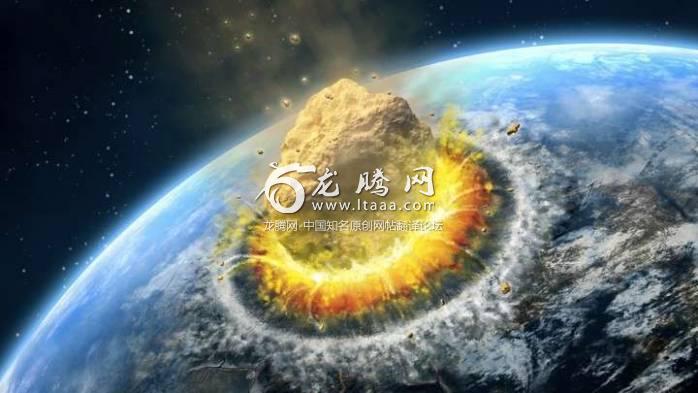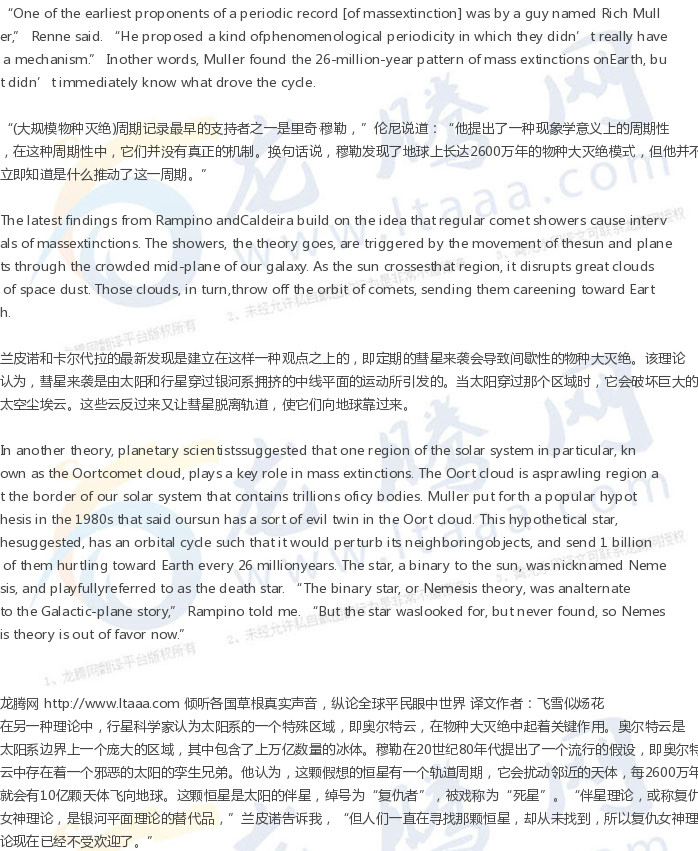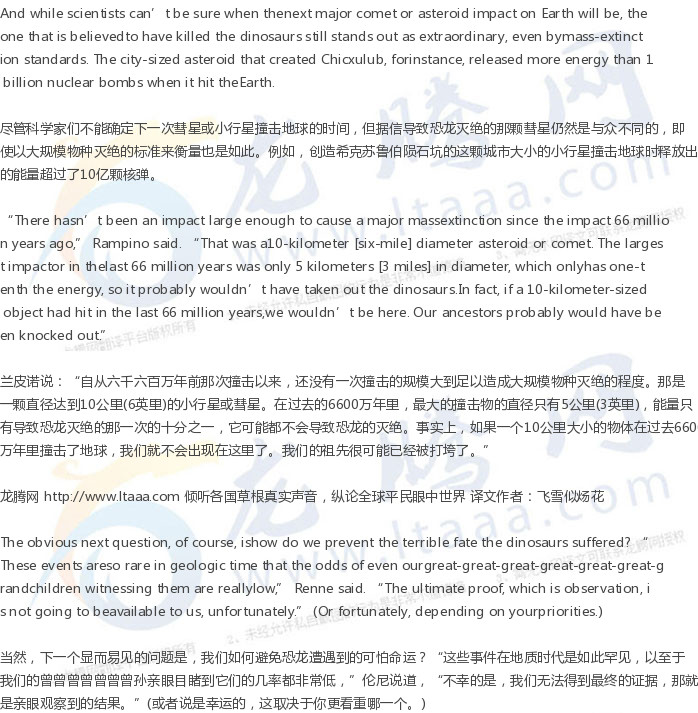《大西洋月刊》:大规模物种灭绝的可怕规律 [美国媒体]
我们可以肯定的一件事是,我们可以说在恐龙灭绝的那一刻,地球上的环境对它们来说是不愉快的。相互交替和相互重叠的不同理论认为,这些巨兽是被巨大的彗星攻击、被巨大的海啸淹没、被熔岩烧焦、被植被的贫瘠饿死、被濒死的超新星的辐射炸飞、在数十年的黑暗中消失,或者是在冰河时代被冻死了。
The Chilling Regularity of Mass Extinctions
大规模物种灭绝的可怕规律
One thing we know for sure is thatconditions on Earth were, shall we say, unpleasant for the dinosaurs at themoment of their demise. Alternate and overlapping theories suggest the greatbeasts were pelted with monster comets, drowned by mega-tsunamis, scorched withlava, starved by a landscape stripped of vegetation, blasted with the radiationof a dying supernova, cloaked in decades of darkness, and frozen in an ice age.
我们可以肯定的一件事是,我们可以说在恐龙灭绝的那一刻,地球上的环境对它们来说是不愉快的。相互交替和相互重叠的不同理论认为,这些巨兽是被巨大的彗星攻击、被巨大的海啸淹没、被熔岩烧焦、被植被的贫瘠饿死、被濒死的超新星的辐射炸飞、在数十年的黑暗中消失,或者是在冰河时代被冻死了。
Renne is the author of another new studythat focuses on the Chicxulub crater, the massive divot beneath the YucatánPeninsula that was created by the same impact blamed for the extinction of thedinosaurs. Renne and his colleagues believe that the comet or asteroid thatblasted into Earth and made Chicxulub also set off a global chain-reaction ofvolcanic eruptions that accelerated the end of the dinosaurs. Volcanoes were,they believe, erupting continuously for millions of years. Long enough to makeHawaii’s Kilauea, which has been flowing since 1983, seem laughable. (“Kilaueais nothing,” Renne told me. “Kilauea is a flea.”)
伦尼是另一项新研究的作者,该研究的重点是奇克苏鲁伯陨石坑。奇克苏鲁伯陨石坑位于尤卡坦半岛以南地区,它是由导致恐龙灭绝的那次撞击形成的巨大凹陷地形。伦尼和他的同事们认为,撞击地球并形成希克苏鲁伯陨石坑的彗星或小行星也引发了全球火山爆发的连锁反应,从而加速了恐龙的灭绝。他们相信火山在几百万年时间里一直在持续喷发。其时间长到足以让夏威夷的基拉韦厄火山——这座火山自1983年以来一直在喷发——显得非常可笑。(“基拉韦厄火山什么都不是,”伦尼告诉我,“它就是一只跳蚤。”)
And while Renne is interested in thepossibility that volcanism is tied to intervals of mass extinction, thatpossible connection doesn’t explain what kind of cycles might trigger the awakeningof Earth’s most powerful magma systems on a global scale. That’s wheretheories about galactic periodicity come back into play.
尽管伦尼对火山活动与大规模物种灭绝之间存在联系的可能性很感兴趣,但这种可能的联系并不能解释什么样的周期可能在全球范围内触发地球上最强大的岩浆系统的觉醒。这就是关于银河周期的理论发挥作用的地方。
“[Muller] doesn’t even believe that anymore,” Renne told me.
“甚至连(穆勒)自己都不再相信这一点了,”伦尼告诉我。
If Rampino and Caldeira are correct, thenext mass extinction may not be far off—in geologic terms, anyway. Our littlecorner of the solar system crossed the plane about 2 million years ago, and weare now moving up and through it. “In the Galactic theory, we are near theGalactic plane, and we have been in the danger zone for a couple of millionyears,” Rampino said. “We are still close to the plane, maybe 30 light yearsabove the plane, [and] a light year is 6 trillion miles … We won’t come backacross the plane for about another 30 million years.”
如果兰皮诺和卡尔代拉的预测是正确的,那么从地质学的角度来说,下一次物种大灭绝也许就为时不远了。我们太阳系的这个小角落大约在200万年前穿过了这个平面,我们现在正在向上移动并穿过它。“在星系理论中,我们在星系平面附近,我们已经处于这个危险地带几百万年了,”兰皮诺说,“我们仍然离这个平面很近,可能在平面上方30光年的地方,而一光年是6万亿英里……而大约在3000万年之后,我们才会再次穿越这个平面。”
In the meantime, scientists are activelyscouring the skies, and calculating the orbits of monstrous comets andasteroids. “So far, none are on a collision course, but the work has just begunin earnest,” Rampino said. “Once we know one is coming, then there are severaloptions to divert the object. (You don’t want to blow it up, that will justincrease the numbers of impactors.) One possibility is to have a nuclearexplosion off to one side of the comet or asteroid, pushing it just slightlyoff course, or possibly just hitting the object with a rapidly movingspace-craft would provide enough of a nudge.”
与此同时,科学家们正在积极地搜索天空,计算体积巨大的彗星和小行星的轨道。兰皮诺说:“到目前为止,还没有会发生撞击的天体,但是工作才刚刚开始。一旦我们知道有一颗小行星要来了,就会有几种可供选择的方式来转移目标。”(你不会想着把它炸毁,那样只会增加撞击物的数量。)一种可能性是,让核爆炸发生在彗星或小行星的一侧,将其稍稍推离轨道,或者干脆用一架快速移动的航天器撞击该物体,就足以提供足够的推力了。
版权声明
我们致力于传递世界各地老百姓最真实、最直接、最详尽的对中国的看法
【版权与免责声明】如发现内容存在版权问题,烦请提供相关信息发邮件,
我们将及时沟通与处理。本站内容除非来源注明五毛网,否则均为网友转载,涉及言论、版权与本站无关。
本文仅代表作者观点,不代表本站立场。
本文来自网络,如有侵权及时联系本网站。
图文文章RECOMMEND
热门文章HOT NEWS
-
1
Why do most people who have a positive view of China have been to ...
- 2
- 3
- 4
- 5
- 6
- 7
- 8
- 9
- 10
推荐文章HOT NEWS
-
1
Why do most people who have a positive view of China have been to ...
- 2
- 3
- 4
- 5
- 6
- 7
- 8
- 9
- 10














